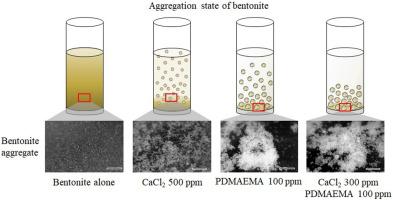当前位置:
X-MOL 学术
›
Colloids Surf. A Physicochem. Eng. Aspects
›
论文详情
Our official English website, www.x-mol.net, welcomes your feedback! (Note: you will need to create a separate account there.)
Effects of calcium chloride and poly(N,N-dimethylaminoethyl methacrylate) on the filtration rate of a bentonite suspension and the examination of the filtration mechanism
Colloids and Surfaces A: Physicochemical and Engineering Aspects ( IF 5.2 ) Pub Date : 2020-10-01 , DOI: 10.1016/j.colsurfa.2020.125265 Ayano Nakamura , Hiromu Sato , Yusuke Sato , Kenji Murakami
Colloids and Surfaces A: Physicochemical and Engineering Aspects ( IF 5.2 ) Pub Date : 2020-10-01 , DOI: 10.1016/j.colsurfa.2020.125265 Ayano Nakamura , Hiromu Sato , Yusuke Sato , Kenji Murakami

|
Abstract A bentonite suspension (1 wt%) was filtered, employing a cationic polymer, poly(N,N-dimethylaminoethyl methacrylate) (PDMAEMA), and an electrolyte, calcium chloride (CaCl2), as flocculants at a pH and temperature of 6 and 50 °C, respectively. The effect of the flocculant concentrations on the filtration rate (FR) was investigated. Additionally, the filtration mechanism was examined by calculating the specific cake resistance (SCR), investigating the size of the aggregates, and by X-ray diffraction (XRD) analysis. FR increased and SCR decreased with increasing flocculant concentrations. Furthermore, FR, with PDMAEMA, significantly increased at a lower concentration than with CaCl2. The microscopic observation revealed that aggregates were formed when CaCl2 (≥ 300 ppm) or PDMAEMA (≥ 25 ppm) were utilized. Additionally, it was clarified that the aggregate size with PDMAEMA was much larger than that with CaCl2, and that FR increased as the aggregate size increased. FR was further improved when both 100 ppm PDMAEMA and 300 ppm CaCl2 were added to the suspension. In the XRD pattern, it was observed that the peak intensity, attributed to the (001) plane between the bentonite layers, increased with increasing CaCl2 concentration. From this result, it was assumed that large and hard aggregates were formed by aggregating CaCl2 between bentonite layers and crosslinking the layers with PDMAEMA. Therefore, SCR decreased and the filtration rate increased.
中文翻译:

氯化钙和聚(N,N-二甲氨基乙基甲基丙烯酸酯)对膨润土悬浮液过滤速率的影响及过滤机理研究
摘要 过滤膨润土悬浮液 (1 wt%),采用阳离子聚合物聚(N,N-二甲基氨基乙基甲基丙烯酸酯)(PDMAEMA)和电解质氯化钙(CaCl2)作为絮凝剂,pH 值为 6,温度为 6 和分别为 50°C。研究了絮凝剂浓度对过滤速率 (FR) 的影响。此外,通过计算比滤饼阻力 (SCR)、研究聚集体的尺寸和 X 射线衍射 (XRD) 分析来检查过滤机制。随着絮凝剂浓度的增加,FR 增加而 SCR 减少。此外,与使用 CaCl2 相比,使用 PDMAEMA 的 FR 在较低浓度下显着增加。显微镜观察显示,当使用 CaCl2 (≥ 300 ppm) 或 PDMAEMA (≥ 25 ppm) 时,会形成聚集体。此外,澄清了 PDMAEMA 的聚集体尺寸远大于 CaCl2 的聚集体尺寸,并且 FR 随着聚集体尺寸的增加而增加。当 100 ppm PDMAEMA 和 300 ppm CaCl2 都加入悬浮液时,FR 得到进一步改善。在 XRD 图中,观察到归因于膨润土层之间的 (001) 面的峰强度随着 CaCl2 浓度的增加而增加。从这个结果可以推测,通过在膨润土层之间聚集 CaCl2 并用 PDMAEMA 交联这些层,可以形成大而硬的聚集体。因此,SCR 降低,过滤速率增加。在 XRD 图中,观察到归因于膨润土层之间的 (001) 平面的峰强度随着 CaCl2 浓度的增加而增加。从这个结果可以推测,通过在膨润土层之间聚集 CaCl2 并用 PDMAEMA 交联这些层,可以形成大而硬的聚集体。因此,SCR 降低,过滤速率增加。在 XRD 图中,观察到归因于膨润土层之间的 (001) 平面的峰强度随着 CaCl2 浓度的增加而增加。从这个结果可以推测,通过在膨润土层之间聚集 CaCl2 并用 PDMAEMA 交联这些层,可以形成大而硬的聚集体。因此,SCR 降低,过滤速率增加。
更新日期:2020-10-01
中文翻译:

氯化钙和聚(N,N-二甲氨基乙基甲基丙烯酸酯)对膨润土悬浮液过滤速率的影响及过滤机理研究
摘要 过滤膨润土悬浮液 (1 wt%),采用阳离子聚合物聚(N,N-二甲基氨基乙基甲基丙烯酸酯)(PDMAEMA)和电解质氯化钙(CaCl2)作为絮凝剂,pH 值为 6,温度为 6 和分别为 50°C。研究了絮凝剂浓度对过滤速率 (FR) 的影响。此外,通过计算比滤饼阻力 (SCR)、研究聚集体的尺寸和 X 射线衍射 (XRD) 分析来检查过滤机制。随着絮凝剂浓度的增加,FR 增加而 SCR 减少。此外,与使用 CaCl2 相比,使用 PDMAEMA 的 FR 在较低浓度下显着增加。显微镜观察显示,当使用 CaCl2 (≥ 300 ppm) 或 PDMAEMA (≥ 25 ppm) 时,会形成聚集体。此外,澄清了 PDMAEMA 的聚集体尺寸远大于 CaCl2 的聚集体尺寸,并且 FR 随着聚集体尺寸的增加而增加。当 100 ppm PDMAEMA 和 300 ppm CaCl2 都加入悬浮液时,FR 得到进一步改善。在 XRD 图中,观察到归因于膨润土层之间的 (001) 面的峰强度随着 CaCl2 浓度的增加而增加。从这个结果可以推测,通过在膨润土层之间聚集 CaCl2 并用 PDMAEMA 交联这些层,可以形成大而硬的聚集体。因此,SCR 降低,过滤速率增加。在 XRD 图中,观察到归因于膨润土层之间的 (001) 平面的峰强度随着 CaCl2 浓度的增加而增加。从这个结果可以推测,通过在膨润土层之间聚集 CaCl2 并用 PDMAEMA 交联这些层,可以形成大而硬的聚集体。因此,SCR 降低,过滤速率增加。在 XRD 图中,观察到归因于膨润土层之间的 (001) 平面的峰强度随着 CaCl2 浓度的增加而增加。从这个结果可以推测,通过在膨润土层之间聚集 CaCl2 并用 PDMAEMA 交联这些层,可以形成大而硬的聚集体。因此,SCR 降低,过滤速率增加。


























 京公网安备 11010802027423号
京公网安备 11010802027423号